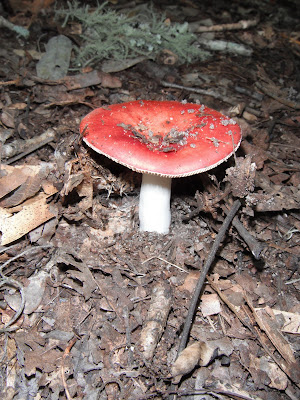 There was also some swamps in the area. But unlike the wet sinks, they were mostly dry. The forest itself was dry and a lot of the foliage was turning brown. However, we still got glimpses of some beautiful flowers hidden here and there.
There was also some swamps in the area. But unlike the wet sinks, they were mostly dry. The forest itself was dry and a lot of the foliage was turning brown. However, we still got glimpses of some beautiful flowers hidden here and there. There were also a surprising number of mushrooms about especially given how dry it was. This one looked awesome, it may be a Russula pulchra.
There were also a surprising number of mushrooms about especially given how dry it was. This one looked awesome, it may be a Russula pulchra. There was also this crazy-looking batch of mushrooms which I am fairly sure are earthstars, or some other puffball type mushrooms. These explode spores out through the top of their body when they get ripe enough. The white ones are unexploded, and the brown one has already released its spores. Probably the best thing that I saw in the park!
There was also this crazy-looking batch of mushrooms which I am fairly sure are earthstars, or some other puffball type mushrooms. These explode spores out through the top of their body when they get ripe enough. The white ones are unexploded, and the brown one has already released its spores. Probably the best thing that I saw in the park! Of course what I've learned about Florida is that it is all bugs, and things that eat bugs. We saw our fair share of dragonflies, bees, gnats, and a lot of grasshoppers. We also saw this Golden Orb Weaver, which I had originally seen in the LA Natural History Museum's spider pavilion. It was definitely something to see it in the wild! I though it was from some far away country like Malaysia.
Of course what I've learned about Florida is that it is all bugs, and things that eat bugs. We saw our fair share of dragonflies, bees, gnats, and a lot of grasshoppers. We also saw this Golden Orb Weaver, which I had originally seen in the LA Natural History Museum's spider pavilion. It was definitely something to see it in the wild! I though it was from some far away country like Malaysia. We also saw these awesome beetles. They were quite large, about the size of my thumb, or a little smaller.
We also saw these awesome beetles. They were quite large, about the size of my thumb, or a little smaller. The biggest find of the day was this beautiful five lined skink. We saw it near the big dismal sink, where it was hanging out inside the tree.
The biggest find of the day was this beautiful five lined skink. We saw it near the big dismal sink, where it was hanging out inside the tree.Of course, I nearly had a heart attack when a big group of people stomped by and scared it away before I could get a picture... But a little patience and it came back again and I got the shot!





















